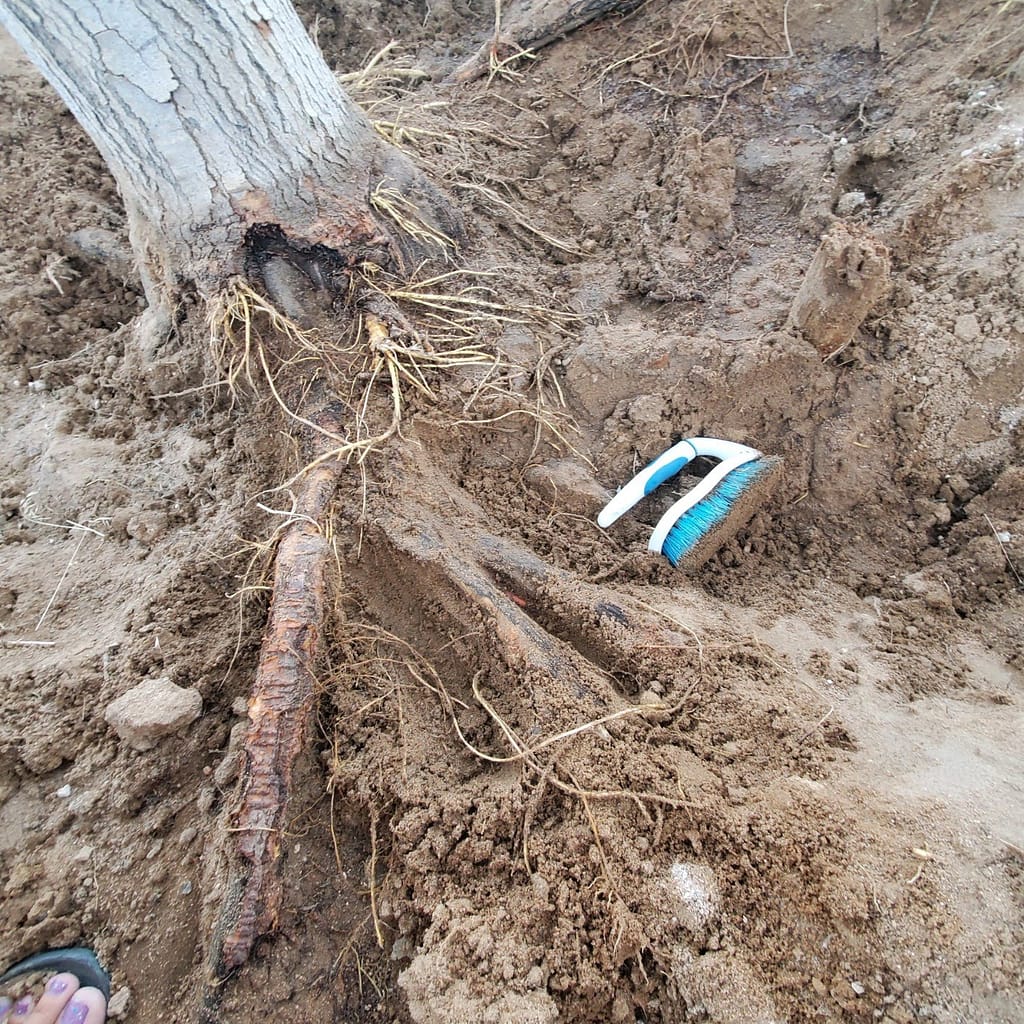
Exposing the surface roots and removal of a rotten portion on the trunk
What Are Crown and Root Rot?
Crown rot and root rot are two types of pathogens that cause deterioration of the root system or the lower trunk of woody plants. This is more commonly an acute problem, but can also show up as a chronic issue that doesn’t immediately lead to the death of a tree or plant.
There are several different fungi and bacteria that can cause root and crown rots. Root rots include (but are not limited to) Phytophthora, Ganoderma, Leptographium (Verticicladiella), Rhizoctonia and Thielaviopsis, while crown (or collar) rots include (but are not limited to) Sclerotium, Pythium and Fusarium species.
Phytophthora thrives in wet soil conditions, or in free standing water. Rhizoctonia however, can still take hold under drier conditions than phytophthora. They both attack the root system and can weaken the entire plant which allows for other fungi and bacteria to colonize the plant and further damage or kill the plant.
Crown or collar rots occur on the surface of the plant at the “crown” of herbaceous plants, or the “collar” or root flare of woody trees or shrubs.
Specific diseases that are either crown or root rots are:
- Armillaria Root Rot (Oak Root Fungus)
- Crown Rot of Perennials (Southern Blight)
- Ganoderma Root Rot
- Phytophthora Root Rot of Conifers
- Phytophthora Root Rot of Trees and Shrubs
- Procera Root Rot of White Pines
- Pythium Blight of Turf
- Black Root Rot
Symptoms and Identification of Crown and Root Rots
Symptoms from crown and root rots are usually identified by above ground symptoms, and often are misdiagnosed as another problem before eventually being recognized as a rot. Symptoms can include:
- Stunted growth
- Wilting leaves
- Thin canopy
- Yellow, red or off colored foliage
- Small, pale leaves
- Gradual or quick decline
- Branch dieback
- Cankers or sunken areas on the trunk
As you can see, these are symptoms of many other problems as well. Wilting leaves might lead you to think overwatering, branch dieback might lead you to think borers or other pests, and off colored leaves can make you think nutrient deficiency.
The best way to identify a root rot is by digging down into the soil to inspect the roots. If roots are dark and limp, then you have found your culprit. White root tips and tough woody roots are indicators that they are not rotting. Keep in mind that if a portion of the plant’s root system is rotting, but not all of it is, you may still want to take precautions to not help the pathogen spread to the rest of the root system.
On older plants, things such as watering changes, flooding, excessive rain, addition of large mulch layers after establishment, damage to root system through digging or heavy machinery can all cause a great environment for root rots to take hold.
For images of plants with crown or root rots scroll to the bottom for help in identifying if it is affecting your plant. If you have photos you’d like to add to the photos below you can send them to [email protected].
Life Cycle
Once crown or root rots infect the soil or plant, it is difficult, if not impossible to eliminate the pathogen. They can survive in the soil, by seed (certain species), in plant tissue, and can be spread by splashing water, infected soil being moved, and through the roots from one plant to another.
Management of Crown and Root Rots
Best management of these rots include avoiding waterlogged soil. Root rots generally thrive in wet soils and need it to complete its life cycle. Maintaining a drier soil (by watering less frequently but thoroughly) helps to keep this pathogen at bay.
Monitoring
Monitoring can be difficult as symptoms are similar to other problems, and you can’t see the roots. Crown rots can be noticed easier as they are above the soil surface. The list of things mentioned in the identification section can help to diagnose and notice the problem to begin with.
Cultural Control
Avoiding wet soils, damage to lower trunks from mowers or trimmers, and excavation of the root zone can all help to keep this from becoming an issue. Using soil that drains well, or avoiding the planting of plants in waterlogged soil, can also be a great way to mitigate the potential for root rots.
Chemical Control
While there are fungal control methods for managing crown and root rots, you should contact your local cooperative extension for help in knowing which to use. Using the wrong fungicide by not knowing which pathogen is the culprit can increase the damage that the fungus can do.
Toxicity
As with almost all chemicals there is an associated toxicity rating for the active ingredients of different pesticides, fungicides, herbicides, and rodenticides. Here are a few places you can learn more about their toxicity with a table of their rating and what the rating means (first is the preferred):
http://pods.dasnr.okstate.edu/docushare/dsweb/Get/Document-3591/EPP-7457web.pdf
https://extension.psu.edu/toxicity-of-pesticides
